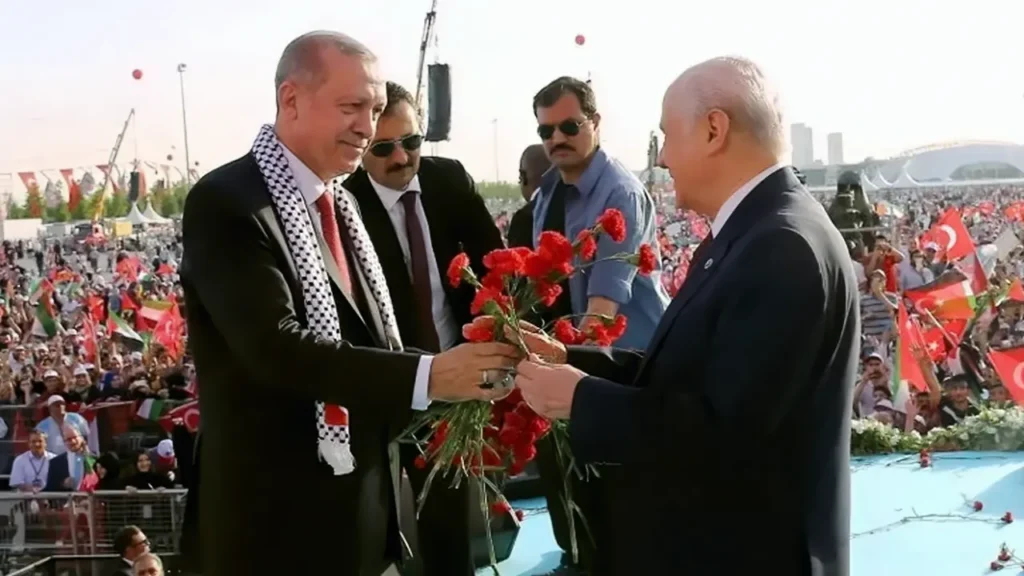The political line pursued by the Nationalist Movement Party (MHP) after the June 7, 2015 elections created the most critical rupture in the party’s history. Growing increasingly close to the AK Party, which it had previously opposed, the MHP soon became an official partner under the umbrella of the “People’s Alliance.” During this period, the İYİ Party emerged from within the MHP, and later, the Victory Party broke away from the İYİ Party; nevertheless, the MHP managed to maintain its vote share around the 10% threshold in all elections. Although the MHP’s ability to retain this level of support is generally perceived by the public as a success, the analyses presented in this article reveal that since 2015, the profile of MHP voters has undergone significant changes. This transformation in voter attitudes reveals that MHP supporters have developed perspectives on the monarchy, the republic, and Atatürk’s legacy that resemble those of AK Party and DEM Party voters, while increasingly diverging from the bases of opposition parties.
One of the key points that draws public attention is how the MHP has managed to preserve its vote share. Despite the departure of the İYİ Party, and subsequently, the Victory Party from the İYİ Party, the MHP has consistently stayed around the 10% mark in every election. This success appears even more striking on a national scale: when considering that the MHP’s vote share had risen to 16.3% on June 7, 2015, and that in 2023 the İYİ Party received 9.6% and the Victory Party 2.2%, the MHP maintaining a 10% share is indeed notable. However, focusing solely on these percentages can be misleading; our analyses indicate that the MHP’s voter composition has evolved considerably since 2015.
Figure 1 below has been prepared to shed light on the changing voter profile of the MHP. The horizontal axis of the figure represents the SEGE (Socio-Economic Development Index), which measures how advanced each province is based on key indicators such as education, income, healthcare, and infrastructure. Provinces with higher scores are considered more advantaged in terms of social and economic opportunities, while those with lower scores are seen as relatively underdeveloped. The values on the vertical axis reflect the change in MHP’s vote share between the parliamentary elections held on June 7, 2015 and May 14, 2023. This allows us to directly observe in which provinces, based on their level of development, the MHP lost votes, maintained its support, or gained votes.
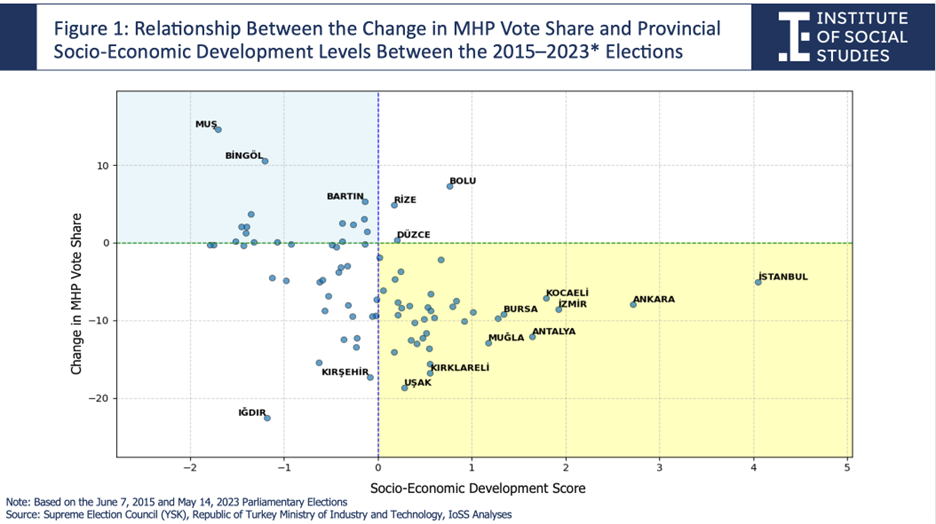
Two striking points emerge here. The first is the provinces where the MHP increased its vote share between the two elections. These are represented in Quadrants I and II. However, what stands out is that the majority of provinces where the MHP gained votes are concentrated in Quadrant I. In other words, after forming an alliance with the AK Party, the MHP managed to increase its vote share almost exclusively in regions that fall below the national average in terms of socio-economic development, with only three exceptions.
In contrast, the provinces where the MHP experienced a decline in its vote share are in the majority. What is particularly noteworthy, however, is that the regions where this decline occurred are largely those that rank above the national average in socio-economic development. These regions are represented in Quadrant IV. It is highly significant that not only Türkiye’s three largest cities fall within this quadrant, but also industrially developed provinces such as Bursa, Kocaeli, Antalya, Kırklareli, and Denizli. From a historical perspective, modern nationalism has been directly associated with the axes of expanding trade, industrialization, and urban culture. Yet, a party that claims to represent Turkish nationalism is increasingly distancing itself from the very regions where industry, commerce, and cultural capital are most concentrated.
Apart from the analysis presented above, another method we can use to understand the transformation in MHP’s voter base is to compare the party’s vote share at the provincial level with that of other parties. Figure 2 below illustrates how the MHP’s provincial-level vote distribution between 2015 and 2023 aligns with or diverges from that of the CHP and the AK Party. By examining the correlation between the vote shares of these three political parties across provinces, we can draw conclusions about the extent to which their respective voter profiles resemble each other on a regional basis.
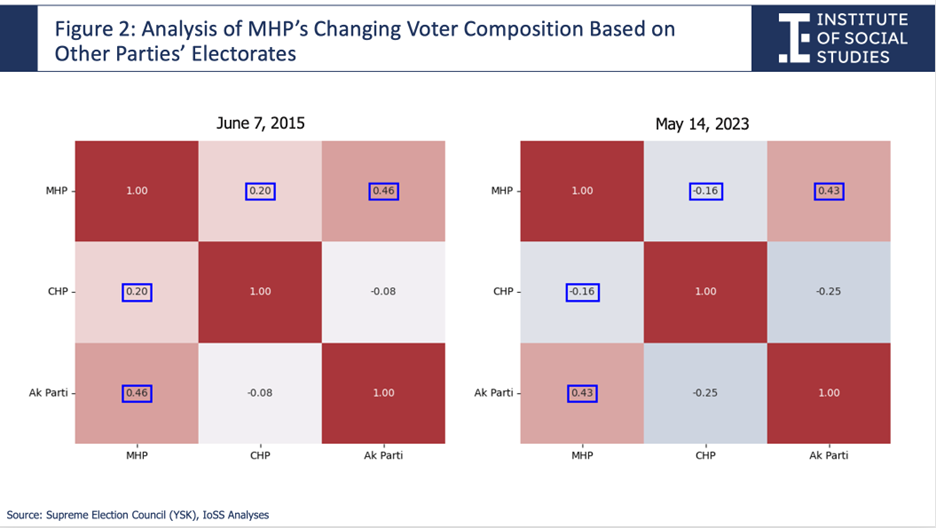
According to the analysis reflected in Figure 2, on June 7, 2015, there was a weak but positive correlation between the vote shares of the MHP and the CHP (r = 0.20). In contrast, the relationship between the MHP and the AK Party was stronger (r = 0.46). This indicates that, at the time, provinces where the MHP performed well tended to be those where the AK Party also received relatively high levels of support, while there was only limited overlap with the CHP. However, by May 14, 2023, the correlation between the MHP and the CHP had turned negative (r = –0.16), while the MHP–AK Party correlation remained clearly positive at 0.43. This suggests that the MHP’s voter base has moved further away from the CHP and closer to the AK Party over time, and that the MHP’s local support dynamics have evolved in a direction increasingly inverse to those of the CHP but consistently aligned with those of the AK Party.
Another way to analyze the transformation of the MHP electorate is to evaluate the party’s electoral performance in comparison to the CHP and AK Party in 2015 and 2023. According to this analysis, in the top 10 provinces where the AK Party received the most votes in the June 7, 2015 elections, the MHP’s average vote share was 19.4%. By the May 14, 2023 elections, this figure had dropped to 14.2%. In 2015, the MHP’s average vote share in the 10 provinces where the CHP performed strongest was 17%, but this fell sharply to 8.1% in 2023.
The above analyses are of critical importance in understanding the current cooperation between the MHP and the AK Party, particularly as the two parties now signal alignment on major issues such as a “Terror-Free Türkiye” and drafting a new constitution. The analyses presented thus far have been based on regionally defined levels of socio-economic development. However, the convergence in voter profiles between the two parties extends beyond socio-economic dimensions; it is also reflected in conceptual and political outlooks. This alignment in voter composition provides crucial insight into the political mindset that will shape the drafting of the new constitution.
One of the key sources we can draw upon to illustrate the convergence between voter bases in terms of specific political and conceptual dimensions is the Society 2024 survey conducted by the Institute for Social Research, published on October 10, 2024. In this study, respondents were asked their opinions regarding the abolition of the sultanate/monarchy and the establishment of the Republic. The distribution of responses to this question, broken down by party affiliation, is presented below.
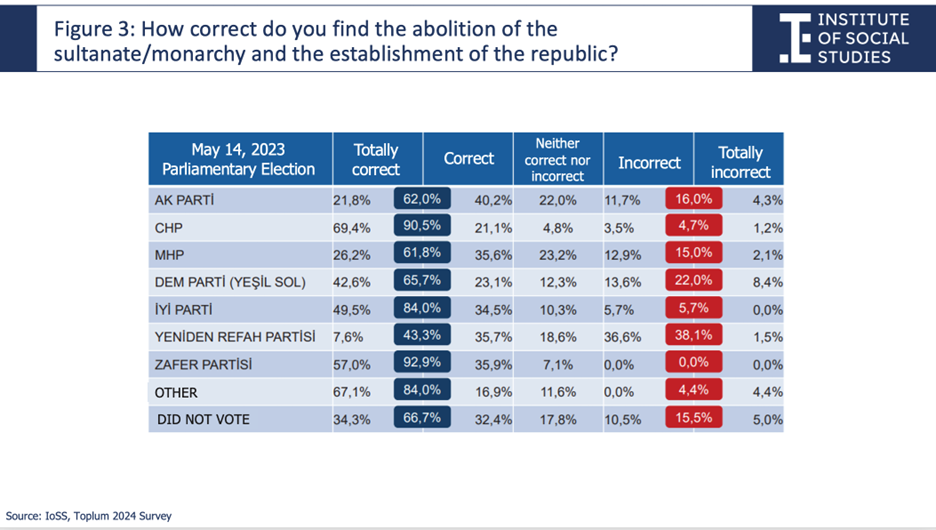
As shown in Figure 3, there is a strong level of approval across all party voter bases for the question: “To what extent do you think it was right to abolish the sultanate/monarchy and establish the Republic?” However, there is a noticeable concentration of voters from certain parties who disapprove of this historical transition. These parties are the MHP, AK Party, DEM Party, and the New Welfare Party (YRP). It should also be noted that within the voter bases of these parties, the proportion of respondents who answered “neither right nor wrong” is significantly high. This notable degree of hesitation or disapproval indicates that democratic consensus on one of the most critical turning points in Türkiye’s political history, the abolition of the sultanate and the proclamation of the Republic, is not uniformly shared across society. In particular, there is evident resistance to republican values among segments of the YRP and DEM Party electorates, as well as parts of the MHP and AK Party voter bases.
Another example of convergence in voter profiles can be found in responses to a question about Atatürk, also included in the same study. Participants were asked their views on Atatürk, and the responses were analyzed according to party preference. Figure 4 below presents the results of this analysis.
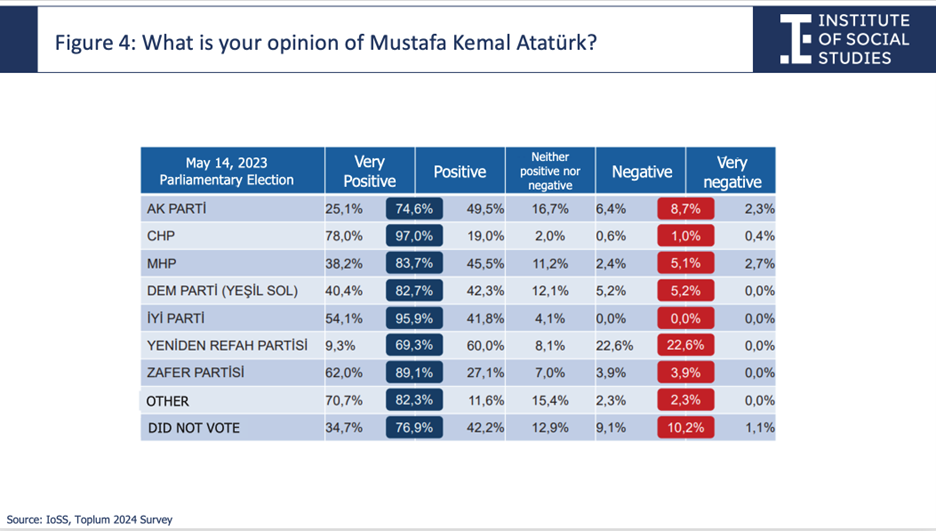
As seen in Figure 4, Atatürk enjoys a very high level of approval across Turkish society. However, the proportion of respondents expressing negative views of Atatürk is noticeably higher among voters of the New Welfare Party (YRP), the DEM Party, and, to a lesser extent, the MHP and the AK Party, compared to other parties. Moreover, the share of respondents answering “neither positive nor negative” is also significantly higher within these same voter bases. This pattern offers valuable insight into the prevailing mindset, especially when considered alongside the observed convergence in voter profiles.
In conclusion, since 2015, the MHP’s voter profile has undergone a significant transformation—both geographically and socioeconomically, as well as ideologically. The analyses indicate that the MHP has lost support in more developed, industrialized provinces where commerce and industry are concentrated, while it has gained support in regions that fall below the national average in terms of socio-economic development. In this sense, the MHP has undergone a marked retreat from the major urban centers, effectively becoming more “provincial.” This process of ruralization has paralleled the decline of the AK Party’s vote share, positioning the MHP as a “safe harbor” for disillusioned AK Party voters. As the MHP withdrew from urban centers and lost much of its earlier voter base to the İYİ Party and the Victory Party, it seems to have distanced itself from the pressure of a more “questioning electorate.” This shift, combined with the compensatory inflow of former AK Party voters, has helped the MHP maintain its overall support levels. Thus, while it is true that the MHP has preserved its voter support rate, it is equally true that its voter profile today is significantly different from what it was ten years ago. In fact, former AK Party voters now constitute the largest group within the MHP’s current support base.

